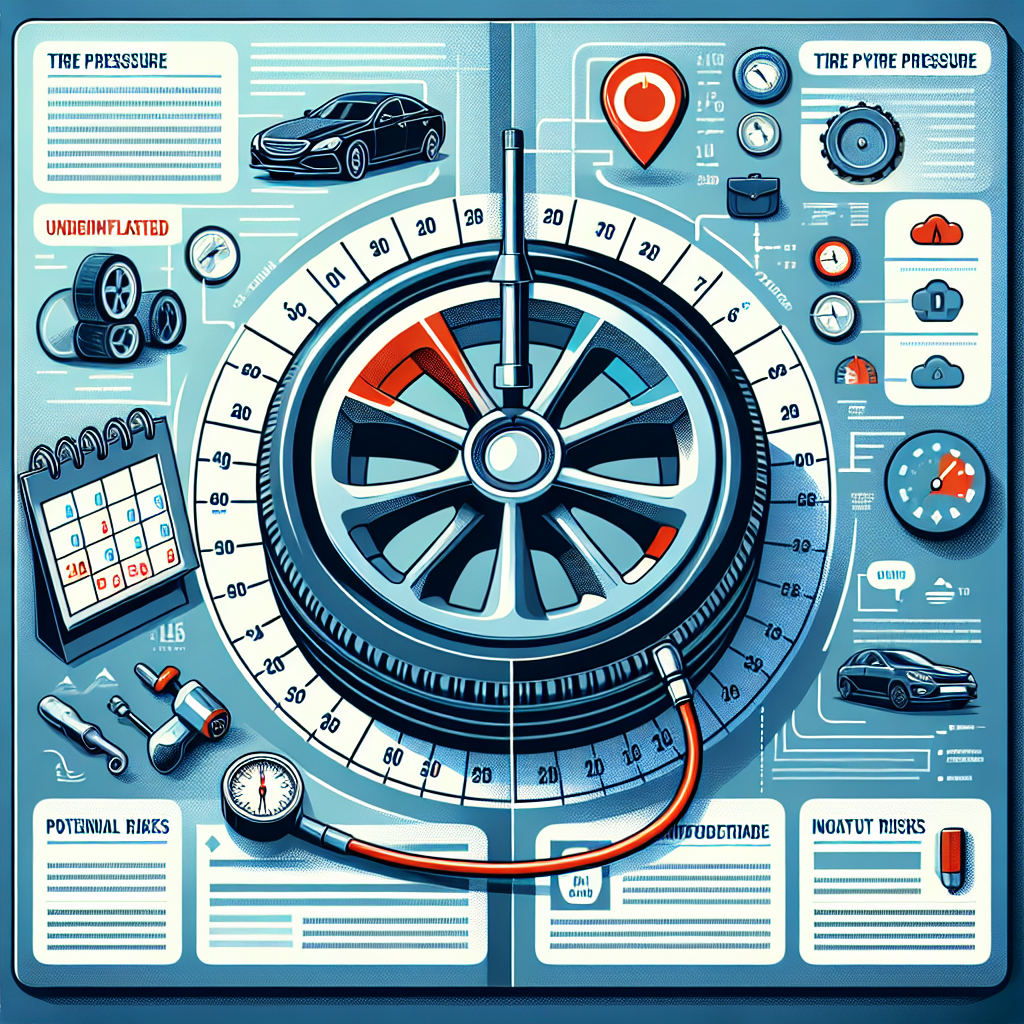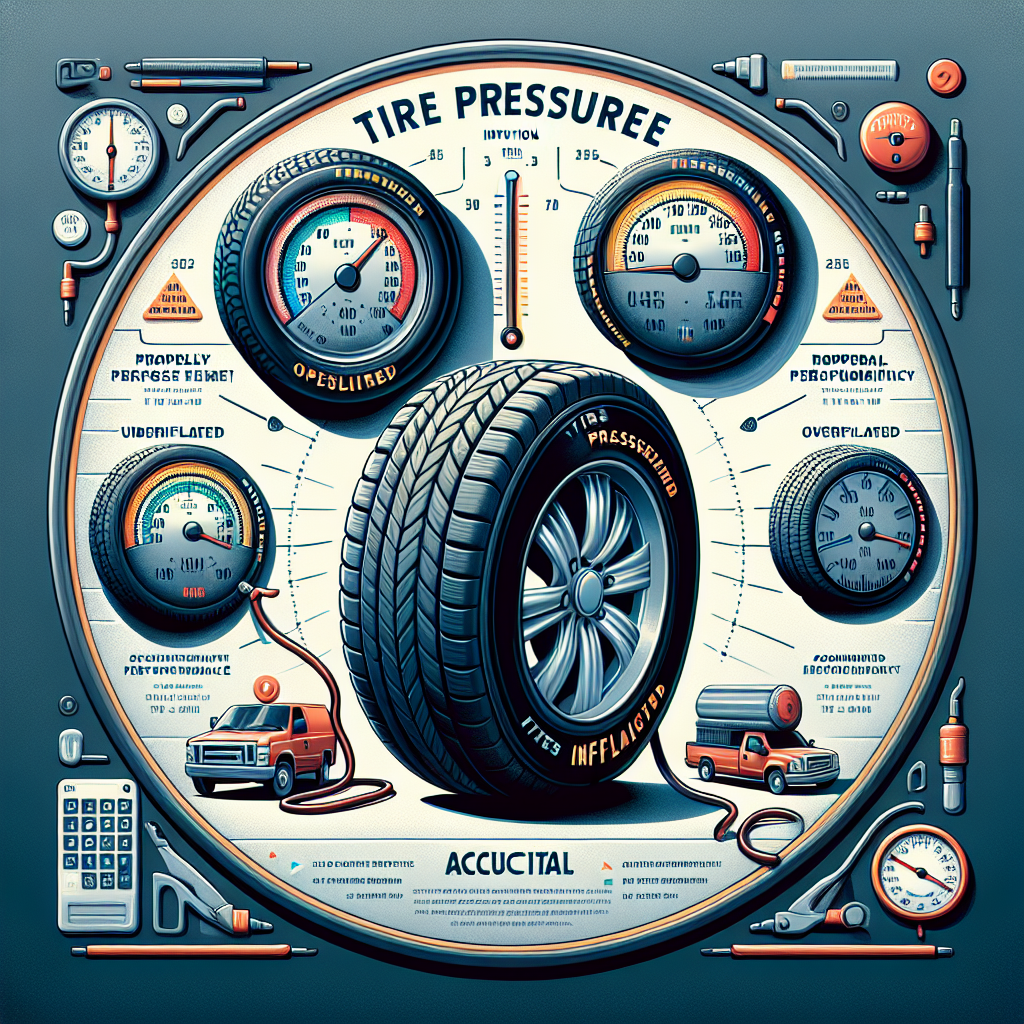Maintaining proper tire pressure is essential for both safety and performance. But how often should you check your tire pressure? It’s a question that many car owners ask themselves, and rightfully so. In this article, we will explore the importance of measuring tire pressure regularly and provide you with some valuable insights on establishing a reliable schedule to ensure your vehicle’s tires stay in top-notch shape. So, buckle up and let’s get started!
Importance of Monitoring Tire Pressure
Safety
Monitoring your tire pressure is essential for your safety on the road. Properly inflated tires provide better traction and control, which is crucial for stopping quickly in emergency situations and maintaining stability while driving. Underinflated tires can cause poor handling, decreased responsiveness, and even lead to accidents. By regularly checking your tire pressure, you can ensure that your vehicle is equipped to handle any unexpected situations.
Fuel Efficiency
Proper tire pressure also plays a significant role in maximizing fuel efficiency. Underinflated tires create more resistance on the road, causing your vehicle’s engine to work harder and consume more fuel. By maintaining the recommended tire pressure, you can reduce this rolling resistance and improve your fuel economy. This not only saves you money at the pump but also contributes to a more sustainable and eco-friendly driving experience.
Tire Lifespan
Monitoring your tire pressure is a simple yet effective way to extend the lifespan of your tires. When your tires are properly inflated, they wear evenly, ensuring a longer tread life. On the other hand, underinflated or overinflated tires cause uneven wear patterns, which can lead to premature wear and the need for replacement sooner than expected. By regularly checking your tire pressure, you can identify any issues early on and address them promptly, thereby prolonging the life of your tires.
Handling and Performance
Maintaining the correct tire pressure is crucial for optimal handling and performance of your vehicle. Underinflated tires can cause poor traction and stability, making it more challenging to control your vehicle during turns or sudden maneuvers. Overinflated tires, on the other hand, reduce the contact area between the tire and the road, leading to decreased grip and compromised handling. By consistently monitoring your tire pressure, you can ensure that your vehicle’s performance remains at its best, providing you with a smoother and safer driving experience.
Factors Affecting Tire Pressure
Temperature
One of the primary factors that affect tire pressure is temperature. As the temperature fluctuates, so does the air pressure inside your tires. In colder weather, the air inside the tires contracts, causing a decrease in tire pressure. Conversely, in hotter weather, the air inside the tires expands, leading to an increase in tire pressure. Consequently, it is essential to regularly check your tire pressure, especially in extreme temperature conditions, to ensure it remains within the recommended range.
Driving Distance
The distance you travel can also impact your tire pressure. Prolonged driving, especially at high speeds, generates heat, which can cause the air inside the tires to expand. This expansion can lead to an increase in tire pressure. Additionally, long-distance trips can also result in minor leaks or punctures, gradually causing a decrease in tire pressure. Therefore, it is advisable to check your tire pressure before embarking on extended journeys and periodically during the trip to maintain optimal pressure levels.
Driving Habits
Your driving habits can affect your tire pressure as well. Aggressive driving, such as sudden stops, starts, and sharp turns, can put additional stress on your tires and cause them to heat up. The increase in temperature can lead to higher tire pressure. Additionally, driving on rough or uneven surfaces can also impact tire pressure. Regularly monitoring your tire pressure, especially if you have a tendency to drive aggressively, can help mitigate any potential risks and maintain optimal tire performance.
Tire Age
The age of your tires can also influence tire pressure. Over time, tires naturally lose air gradually, even without any punctures or leaks. Older tires may experience more significant pressure fluctuations due to their age. Therefore, it is crucial to be extra vigilant about regularly checking the tire pressure of aging tires to ensure they are adequately inflated and safe for use.
Seasonal Changes
Seasonal changes in temperature and environmental conditions can significantly impact tire pressure. As mentioned earlier, colder temperatures cause tire pressure to decrease, while warmer temperatures cause it to increase. As the seasons change, be mindful of these fluctuations and adjust your tire pressure accordingly. For example, in the fall, as temperatures drop, you may need to add air to your tires, while in the spring and summer, you might need to release some air to maintain the recommended pressure.

Recommended Frequency for Tire Pressure Checks
Every Month
It is recommended to check your tire pressure at least once a month as a general rule. Regular monthly checks help identify any gradual pressure loss and allow you to address the issue promptly. By incorporating this simple yet essential task into your routine, you can maintain the safety and performance of your tires consistently. Additionally, monthly checks also ensure that your tires remain properly inflated for optimal fuel efficiency and tire lifespan.
Before Long Trips
Before embarking on long trips, it is vital to check your tire pressure. Long-distance driving can lead to increased tire heat and pressure, making it crucial to start the journey with properly inflated tires. Additionally, verifying the tire pressure before a long trip allows you to identify any punctures or leaks that may have occurred since your last check. By ensuring that your tire pressure is at the recommended level, you can have peace of mind during your journey and minimize the risk of avoidable road incidents.
After Temperature Changes
As mentioned earlier, temperature changes can significantly affect tire pressure. Therefore, after experiencing drastic temperature fluctuations, it is advisable to check your tire pressure. For example, if the weather shifts from a hot summer to a cold winter, or vice versa, it is crucial to monitor your tire pressure and make any necessary adjustments. By doing so, you can ensure that your tires remain within the optimal pressure range, providing you with enhanced safety and performance on the road.
After Replacing Tires or Repairing Punctures
Whenever you replace a tire or repair a puncture, it is essential to measure the tire pressure afterward. These activities can disrupt the equilibrium of the tire and its air pressure. Replacing a tire may involve removing and reinstalling the valve stem, which can cause a slight loss of air. Similarly, repairing a puncture may require removing the tire and temporarily deflating it. After these procedures, it is crucial to measure and adjust the tire pressure to ensure it matches the manufacturer’s recommendations and guarantees optimal performance.
Tools for Tire Pressure Measurement
Tire Pressure Gauge
A tire pressure gauge is a simple and inexpensive tool that allows you to measure the air pressure inside your tires accurately. It usually consists of a small metal pin or valve stem that you press against the tire’s valve to obtain a measurement. Tire pressure gauges come in various types, such as pencil gauges and dial gauges, each with its pros and cons. Regardless of the type you choose, having a tire pressure gauge is essential for maintaining proper tire pressure.
Digital Tire Inflator
A digital tire inflator is an advanced device that not only measures tire pressure but also allows you to add or release air as needed. Digital inflators provide precise readings and feature an easy-to-read digital display, making them user-friendly and convenient. These inflators often come with built-in safety features, such as auto-shutoff when the desired pressure is reached, ensuring that you don’t overinflate your tires accidentally. Investing in a digital tire inflator can make measuring and adjusting tire pressure a breeze.
TPMS (Tire Pressure Monitoring System)
Many modern vehicles come equipped with a Tire Pressure Monitoring System (TPMS). TPMS is an electronic system that monitors the air pressure in your tires and signals the driver if the pressure drops below a certain threshold. This system uses sensors that are integrated into the wheels and wirelessly transmit data to the vehicle’s computer system. The TPMS then displays the tire pressure on the dashboard, alerting you to any deviations from the recommended pressure. If your vehicle has TPMS, regularly checking the display can provide you with real-time tire pressure information.

Steps to Measure Tire Pressure
Park the Vehicle on a Flat Surface
To measure your tire pressure accurately, park your vehicle on a level and flat surface. This ensures that the weight distribution is even across the tires, providing you with more accurate pressure readings. Avoid measuring your tire pressure on an incline or bumpy surface, as this can affect the results.
Remove the Valve Stem Caps
Before measuring the tire pressure, remove the valve stem caps from each tire. The valve stem caps are small plastic caps that protect the valve stems from dirt, dust, and moisture. Unscrew the caps and set them aside in a secure place, making sure not to misplace them.
Press the Tire Pressure Gauge Firmly onto the Valve Stem
Take your tire pressure gauge and align it with the valve stem of the first tire. Press the gauge firmly onto the valve stem to create a seal between the gauge and the tire. Ensure that you hold the gauge straight and steady to prevent any air from escaping during the measurement process.
Read the Pressure Display
After firmly attaching the gauge to the valve stem, wait for a few seconds to allow the pressure reading to stabilize. Most tire pressure gauges feature a clear display that shows the measured pressure in PSI (pounds per square inch) or kPa (kilopascal). Take note of the reading displayed on the gauge.
Compare the Measured Pressure with Manufacturer’s Recommendations
Once you have obtained the tire pressure reading, compare it to the manufacturer’s recommended pressure for your specific vehicle. The recommended pressure can usually be found in the owner’s manual, on a sticker inside the driver’s side door jamb, or in the glove compartment. If the measured pressure is lower than the recommendation, add air using a compressor or inflator. If it is higher, release some air until it reaches the optimal pressure.
Signs of Low Tire Pressure
Poor Handling
If you notice that your vehicle is not handling as well as it used to, it could be a sign of low tire pressure. Underinflated tires have reduced grip and traction, which can result in poor handling and reduced control while driving. If your vehicle feels unstable or less responsive, it’s time to check your tire pressure and ensure it is at the recommended level.
Decreased Fuel Efficiency
Another sign of low tire pressure is decreased fuel efficiency. Underinflated tires create more rolling resistance, causing your vehicle’s engine to work harder and consume more fuel. If you find yourself filling up more frequently than usual, it may be a result of improperly inflated tires. Checking and adjusting your tire pressure can help improve your fuel economy and save you money at the pump.
Uneven or Rapid Tire Wear
Low tire pressure can lead to uneven or rapid tire wear. When your tires are underinflated, the outer edges may wear out faster than the center. The uneven wear pattern decreases the lifespan of your tires and can necessitate premature replacement. Regularly inspect your tires for signs of accelerated wear, such as tread depth differences or cupping, and address any tire pressure issues promptly.
Vibrations While Driving
If you notice excessive vibrations while driving, it could be a symptom of low tire pressure. Underinflated tires create an imbalance in the weight distribution, causing vibrations to be felt in the steering wheel or throughout the vehicle. If you experience such vibrations, it is crucial to check your tire pressure and adjust it accordingly. Properly inflated tires will restore balance and a smoother ride.

Consequences of Overinflated Tires
Reduced Traction
Overinflated tires have reduced contact with the road surface, leading to reduced traction. This lack of grip can compromise your vehicle’s ability to stop quickly or navigate turns safely. With reduced traction, your vehicle becomes more susceptible to skidding or losing control, especially in wet or slippery road conditions. Always ensure that your tires are properly inflated to maintain optimal traction and avoid unnecessary risks.
Uneven Wear
Overinflated tires experience uneven wear patterns, much like underinflated tires. However, instead of the outer edges, overinflated tires wear out faster in the center. This excessive wear at the center of the tire can result in a shorter tread life and the need for replacement sooner than expected. By monitoring and maintaining the proper tire pressure, you can avoid uneven wear and maximize the lifespan of your tires.
Increased Risk of Blowouts
An overinflated tire is more susceptible to blowouts, which occur when the tire bursts due to excessive pressure. Blowouts can be extremely dangerous, especially at high speeds, as they can cause loss of control over the vehicle and result in accidents. Regularly checking your tire pressure and ensuring it is within the recommended range helps prevent overinflation and reduces the risk of catastrophic blowouts.
Consequences of Underinflated Tires
Increased Rolling Resistance
Underinflated tires create more rolling resistance, making it more challenging for your vehicle to move forward. This resistance puts additional strain on the engine, causing it to work harder and consume more fuel. Consequently, driving with underinflated tires can lead to reduced fuel efficiency and increase the frequency of visits to the gas station. By maintaining the proper tire pressure, you can minimize rolling resistance and enjoy improved fuel economy.
Tire Overheating
Underinflated tires generate more heat due to increased friction between the tire and the road. This excessive heat buildup can lead to tire overheating, which can cause tire failure, such as blowouts or tread separation. Driving on underinflated tires for extended periods or at high speeds increases the risk of tire overheating. Regularly monitoring and adjusting your tire pressure to the recommended level helps prevent these hazardous situations.
Tread Separation
Underinflated tires are more prone to tread separation, where the tread of the tire separates from the body or carcass. This separation can result in a sudden loss of control while driving, posing a significant safety risk. Tread separation is often caused by the increased heat buildup and stress on the tire due to underinflation. By maintaining proper tire pressure, you can reduce the likelihood of tread separation and ensure your tires remain intact and functional.
Tire Failure
The consequences of underinflated tires mentioned above, such as blowouts, overheating, and tread separation, can ultimately lead to tire failure. Tire failure can be dangerous, especially when it occurs unexpectedly while driving. A tire failure can cause your vehicle to lose control, leading to accidents and potentially causing harm to you, your passengers, and other road users. Regularly monitoring and maintaining proper tire pressure significantly reduces the risk of tire failure and promotes safer driving.

Tips for Maintaining Proper Tire Pressure
Regular Pressure Checks
Make a habit of regularly checking your tire pressure, ideally once a month or more frequently in extreme temperature conditions. Regular checks allow you to identify any gradual pressure loss and ensure that your tires remain optimally inflated. Set a reminder on your calendar or phone to help you stay consistent with this important maintenance task.
Use the Correct Pressure Level
Refer to your vehicle’s owner’s manual or the sticker located on the driver’s side door jamb to find the recommended tire pressure for your specific vehicle. It’s essential to use the correct pressure level, as different vehicles and tire sizes may require different pressure settings. Always adhere to the manufacturer’s recommendations to maximize safety and performance.
Check Pressure Before Long Trips
Before embarking on long trips, check your tire pressure to ensure it is at the recommended level. Long distances and increased speeds generate more heat and pressure, potentially impacting your tire pressure. By starting your journey with properly inflated tires, you enhance your safety and minimize the risk of tire-related incidents during your trip.
Monitor Pressure Changes
Keep an eye on your tire pressure and monitor any changes. If you notice that your tire pressure consistently drops over a short period or experiences sudden fluctuations, it could indicate a more significant issue, such as a slow leak or a faulty valve stem. In such cases, it is advisable to have your tires inspected by a professional to diagnose and address the underlying problem.
Maintain Balanced Tire Pressure
To ensure optimal handling and performance, it is crucial to maintain balanced tire pressure. This means keeping the pressure the same across all four tires and adhering to the recommended pressure level. Imbalanced tire pressure can cause uneven wear, compromise stability, and affect your vehicle’s overall performance. Regularly check and adjust the tire pressure in all your tires to maintain balance and prolong tire life.
Conclusion
Monitoring your tire pressure is a vital aspect of vehicle maintenance that should not be overlooked. By regularly checking and maintaining proper tire pressure, you ensure your safety on the road, maximize fuel efficiency, promote tire longevity, and optimize the handling and performance of your vehicle. Make it a habit to check your tire pressure at least once a month, before long trips, after temperature changes, and after tire replacements or repairs. Utilize tools such as tire pressure gauges, digital tire inflators, or Tire Pressure Monitoring Systems (TPMS) to make the measurement process easier and more accurate. By staying proactive and mindful of your tire pressure, you can drive with confidence, knowing that your tires are ready to take on the challenges of the road ahead.


